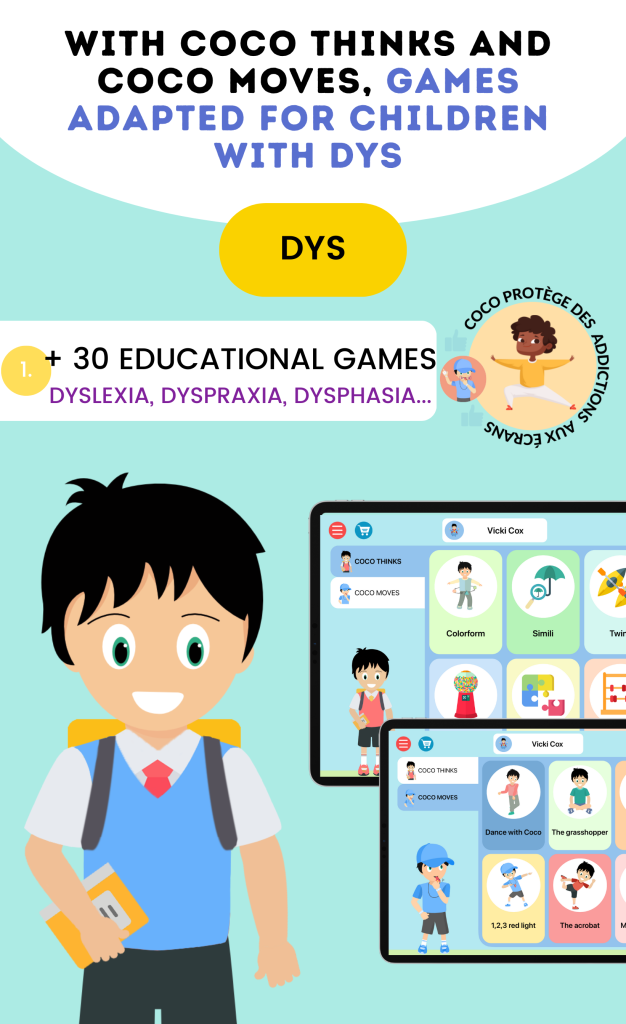Dyslexia, dyspraxia, and dyscalculia, commonly referred to as DYS, are specific learning disorders that affect a child’s ability to read, write, calculate, and perform motor tasks. It is essential to understand the specific needs of these children in order to provide them with a suitable learning environment. This article will explore various strategies for creating an appropriate workspace for DYS children, focusing on organization, reducing distractions, and using suitable tools.
Understanding the Specific Needs of the DYS Child
There are different types of DYS, such as dyslexia (reading and writing difficulties), dyspraxia (motor difficulties), and dyscalculia (mathematics difficulties). Each type of DYS presents its own challenges and requires an individualized approach. For example, a dyslexic child may need a quiet, distraction-free workspace to focus on reading and writing, while a dyspraxic child may require an ergonomic workspace to facilitate motor movements.
DYS children face common challenges such as difficulty concentrating, organizing their ideas, and following instructions. It is important to take these challenges into account when creating a suitable workspace. An individualized approach is essential to meet the specific needs of each DYS child. This may include adaptations in the environment, learning tools, and teaching strategies.
Choosing an Appropriate Workspace
When choosing a workspace for a DYS child, it is important to consider several factors. First, the space should be comfortable and accessible. A DYS child may need an ergonomic chair, an adjustable-height desk, and adequate lighting to avoid fatigue and physical discomfort. Additionally, the space should be large enough to accommodate all necessary learning materials.
It is also important to create a calm and distraction-free workspace. DYS children can be easily distracted by noise or visual stimuli. Therefore, it is best to choose a quiet location, away from distractions such as television or video games. If this is not possible, using noise-canceling headphones or visual dividers can help reduce distractions.
To create a suitable workspace, it is recommended to follow some practical tips. First, ensure that all necessary learning materials are easily accessible. This may include school supplies such as pencils, notebooks, and books, as well as specific tools such as adapted calculators or ergonomic pens. Additionally, it may be helpful to organize supplies using colors and labels to facilitate organization and retrieval.
Creating a Calm and Distraction-Free Environment
Creating a calm and distraction-free environment is essential to help DYS children focus on their learning tasks. Distractions can be particularly problematic for dyslexic children, who often struggle to concentrate on reading and writing. Therefore, it is important to minimize distractions as much as possible.
To create a calm environment, it is recommended to choose a workspace away from noise sources such as television, radio, or video games. If this is not possible, using noise-canceling headphones can help reduce ambient noise. Additionally, it may be helpful to establish a daily routine that includes dedicated learning times, so the child knows what to expect and can focus more easily.
To minimize visual distractions, it is recommended to create a clean and well-organized workspace. Store all unnecessary materials out of sight and use visual dividers to create distinct areas for different activities. Additionally, it may be helpful to use curtains or blinds to block out bright or distracting outside light.
Using Colors and Labels to Organize Supplies
Using colors and labels can be extremely beneficial for DYS children by helping them organize their supplies and find what they need more easily. Color-coding can be used to differentiate between different types of supplies, such as pencils, pens, and notebooks. For example, you can assign a specific color to pencils and another color to pens, so the child can quickly spot the right tool.
Labels can also be used to identify and organize supplies. You can label drawers or storage boxes with words or images to indicate what they contain. For example, you can label a drawer with the word “pencils” or stick an image of a pencil on the pencil storage box. This will allow the child to quickly find what they need without searching for long.
It is important to teach the child how to use color-coding and labels effectively. You can show them how to associate each color with a specific type of supply and explain how to read the labels. Additionally, it may be helpful to create a visual guide that lists all the colors and labels used, so the child can refer to it if necessary.
Adapting Writing and Reading Tools to Facilitate Understanding

Adapting writing and reading tools can greatly help DYS children improve their understanding and academic performance. For example, a dyslexic child may benefit from using special fonts designed to facilitate reading, such as the “OpenDyslexic” font. This font has been specifically designed to help dyslexic individuals differentiate letters and avoid common confusions.
Additionally, using highlighters or colored markers can help DYS children focus on important information while reading. For example, they can highlight key words or important phrases to facilitate understanding. Similarly, using ergonomic pens or pencils with a special grip can help dyspraxic children improve their writing and fine motor skills.
It is important to choose appropriate writing and reading tools based on the specific needs of each DYS child. It may be helpful to consult a special education professional or a speech therapist for specific recommendations. Additionally, it is important to teach the child how to use these tools correctly so that they can make the most of them.
Encouraging Note-Taking and the Use of Visual Organizers
Note-taking and the use of visual organizers can be extremely beneficial for DYS children by helping them organize their ideas and improve their understanding. Note-taking allows the child to summarize important information and organize it in a way that is meaningful to them. This can help them focus on key points and better remember information.
It is important to encourage the child to develop their own note-taking method that works for them. This may include using symbols or drawings to represent ideas, using colors to differentiate between different categories of information, or using charts or diagrams to organize information visually. The important thing is to find a method that helps the child organize their thoughts and remember information.
Visual organizers can also be used to help DYS children organize their ideas and improve their understanding. For example, you can use tables, graphs, or diagrams to visually represent the relationships between different ideas or concepts. Additionally, you can use mind maps or concept maps to help the child organize their thoughts hierarchically.
Using Technological Tools to Assist with Reading and Writing
Technological tools can be extremely useful in helping DYS children improve their reading and writing skills. For example, text-to-speech software can read written texts aloud, which can help dyslexic children better understand and follow information. Additionally, spell checkers and grammar checkers can help DYS children improve their writing by automatically identifying and correcting errors.
There are also applications and software specifically designed to help DYS children improve their reading and writing skills. For example, there are apps that use games and interactive activities to help children practice reading and writing in a fun and engaging way. Additionally, there are word prediction software that can help children find the correct word when they struggle to spell or find it.
It is important to choose appropriate technological tools based on the specific needs of each DYS child. It may be helpful to consult a special education professional or a speech therapist for specific recommendations. Additionally, it is important to teach the child how to use these tools correctly so that they can make the most of them.
Planning Regular Breaks to Avoid Fatigue
Taking regular breaks is essential to avoid fatigue and maintain concentration in DYS children. DYS children may need more time and effort to complete certain tasks, which can lead to increased mental and physical fatigue. Therefore, it is important to plan regular breaks to allow the child to rest and recharge.
It is recommended to plan short breaks every 30 to 45 minutes, depending on the specific needs of each child. During these breaks, the child can take a short walk, stretch, drink water, or simply relax. It is important to encourage the child to use these breaks constructively, avoiding stimulating activities such as video games or television.
It is also important to take into account the individual needs of each child when planning breaks. Some children may need more frequent or longer breaks, while others may prefer shorter and more frequent breaks. It is important to listen to the child’s fatigue signals and adjust the schedule accordingly.
Encouraging Independence and Autonomy in the Child
Fostering independence and autonomy in DYS children is essential to help them develop their self-confidence and learning skills. It is important to give the child age-appropriate responsibilities that match their abilities, so they can feel valued and capable of succeeding.
It is recommended to encourage the child to make decisions and solve problems on their own. For example, you can ask them to choose their own supplies or plan their schedule. Additionally, you can give them specific tasks to complete, such as organizing their supplies or tidying up their workspace. This will allow the child to develop their autonomy and decision-making skills. By giving them responsibilities, you show them that you trust their abilities and encourage them to feel responsible for their own actions. Moreover, this will allow them to learn to solve problems on their own, which is an essential skill for their growth and development. By encouraging the child to make decisions and solve problems independently, you help them become a confident and independent individual.




